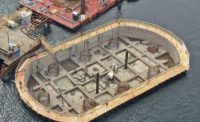Metro North Railroad/Atlantic Street Bridge Replacement Project
Stamford, Conn.
Best Project
Owner: Connecticut Dept. of Transportation
Operating Agency and Stakeholder: Metro North Railroad
Lead Design Firm: AECOM
General Contractor: Halmar International
Construction Engineering and Inspection Firm: ATANE Consulting P.C.
Self-Propelled Modular Transporters: Berard Transportation
DOT Design Liaison Engineer: BL Cos.
Construction Inspection: VN Engineers; Garg Consulting
Engineering Subconsultant: STV
Geotechnical Engineering: GeoDesign
It took intensive planning and tremendous teamwork to install the new Metro North Railroad/Atlantic Street Bridge in busy and congested downtown Stamford, Conn., and to prevent any serious disruption to commuter rail service as well.
The $52.1-million bridge replacement and construction project took place in the middle of one of the busiest rail and highway corridors in the Northeast, all the while maintaining daily rail service for 125,000 commuters on 350 trains a day during the two-year project.
Adjacent to Stamford Train Station, the busiest on the line after Grand Central Terminal, the bridge carries five mainline tracks between the station and Metro North’s main service yard.
In addition, multiple additional constraints impacted the jobsite, including local roadways and Interstate 95.
It was not just commuters who wound up impressed with how smoothly the project went, but also members of the ENR panel of judges, who also happened to be familiar with the tricky and complex nature of the construction site.
One judge noted “the amount of complexity involved, the location of this project and keeping a rail line open into New York City. If anyone has ever taken this line and been in this area, you know what it’s like, and to do this work in the timeframe they did it in [was impressive]. I remember thinking to myself ‘That’s a lot of work to do in that period of time.’”
In order to move forward without disruptions to commuters, intensive planning and management during construction was needed as well as a high level of public outreach.
Construction was timed to coincide with various track outage schedules, which whittled down as many as 1,500 potential schedule modifications to just four.
Further speeding the assembly of the new rail span, a self-propelled modular transporter installed the six bridge sections that had been prefabricated off site.
The project team was able to meet a tight, nine-day window over the July 4th holiday week—a time of historically low ridership—to demolish the existing bridge and install its replacement.
In order to maximize that brief window, the team says it developed an hour-by-hour “readiness plan” for the nine-day bridge roll-in.
The plan ranged from the preparations for the bridge installment to the coordination of activities to restore rail service.
“The reason I gave a high score was [due to] the challenges associated with putting a bridge in place over a holiday weekend and maintaining the four primary rail lines into New York,” another judge on the ENR panel observed. “I thought it was a great team effort and good community involvement in terms of coordination and keeping the area up and running.”







